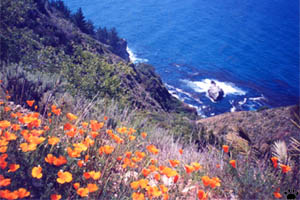
Coast south from Big Sur, California
Alta California
Few parts of our planet are as beautiful as Alta California
(the part of historic California now belonging to the USA). It is one of the places
that any naturalist should try to visit in his lifetime. Unfortunately, for citizens
of some countries it is almost inaccessible because of creative visa policy. Other
areas from a naturalist's "must see" list, such as
Outer Mongolia, selva of Upper Amazon, and Subantarctic islands, are more
easy to get to. Having been born on vast, cold, boring post-glacial plain of European
Russia, I probably enjoyed living in Northern California much more than locals
do. It's so nice to have rainforests, taiga, alpine meadows, Mediterranean grasslands,
oak savannas, sage steppes, and hot deserts within a weekend trip distance!
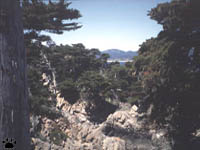
Grove of endemic Monterey cypress (Cupressus
macrocarpa), Point Lobos State Park. |
Besides, some of the World's most productive
waters are just offshore, teeming with whales and other marine
mammals, as well as hundreds of fish species and unfathomable diversity of
invertebrates. |
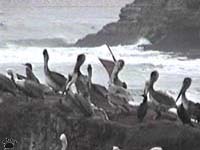
Brown pelicans (Pelecanus occidentalis),
Natural Bridges State Park. |
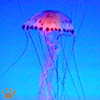 |
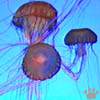 |
Jellyfishes of California:
Chrysaora melanaster,
Ch. hysoscella. Monterey Bay Aquarium. |
|
Underwater wonders of Californian coast
are beyond the scope of this page - you can find some beautiful photos here. |
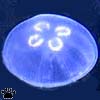 |
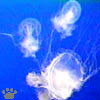 |
Jellyfishes of California:
Aurelia aurita,
Cyanea lamarkii. Monterey Bay Aquarium. |
|

Raccoon tracks on a beach, Lost Coast. |
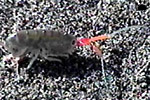
Hammarus sp., Lost Coast. |
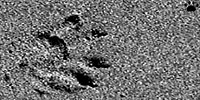
Raccoon tracks on a beach, Lost Coast. |

Pigeon guillemot (Cepphus
columba), Carmel Bay. |
Seabirds from as far as Chukotka, North
Atlantic, Australia and Antarctica show up in Californian waters, some in flocks
of millions. |

Mixed flock of shearwaters
(Puffinus spp.), Monterey Bay. |
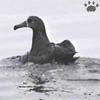 |
 |
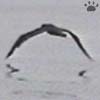 |
| Black-footed albatross
(Diomedea nigripes), Monterey Bay. |

Petroglyphs,
Volcanic Tableland. |
Natural bounty of California has always attracted
people. Before the European arrival, more than 200 languages had been spoken here;
many of them isolated and apparently very old. Some of the oldest archaeological
sites in the New World are also in California. Ohlone shellmounds around San Francisco
Bay are the result of more than 3,000 years of uninterrupted accumulation of human-produced
sediment - the oldest lifespan for a single culture in the history of humanity.
Formerly hunters-gatherers, native Californians are now mostly casino owners or
tourist business operators. |

Ohlone shellmound,
Antioch. |
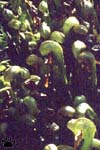
Insectivorous cobra
plant (Darlingtonia
californica), Lake Earl,
Del Norte Coast |
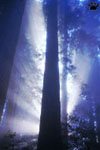
Coastal redwoods
(Sequoia sempervirens),
Tall Trees Grove,
Redwood National Park |
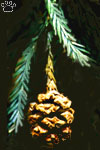
Cone of a coastal
redwood, Headwaters
Forest Preserve
near Eureka. |
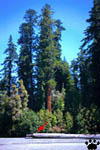
World's tallest trees,
Redwood National Park
(red arrow points at
me standing on a log) |

Rhododendrons
(Rhododendron
macrophyllum),
Del Norte Coast |
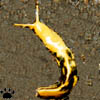
Slug Ariolimnas
columbianus, Eureka. |
My favorite place in California is
Redwood National Park in the northwest. I think it is the World's most beautiful
forest. Redwood trees more than 110 m (330') tall grow here together with many
smaller, but also interesting plants and fungae. Usually wrapped in picturesque,
semi-transparent fog, groves of giant redwoods look
absolutely majestic. |
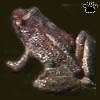
Tailed frog (Asclaphus
truei), Klamath River. |
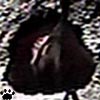
Pileated woodpecker
(Dryocopus pileatus),
Muir Woods. |
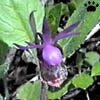
Calypso orchid
(Calypso bulbosa),
Siskiyou Mts. |
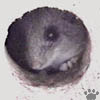
Deer mouse (Peromyscus
maniculatus),
Smith River. |
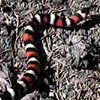
California mountain
kingsnake (Lampropeltis
zonata), Klamath Mts. |

Mountain chickadee
(Parus gambeli),
Cascade Mountains. |

Pacific jumping mouse
(Zapus trinotatus),
Patrick's Point. |
Many wonderful animals inhabit these
forests, but they are usually difficult to see, except for deer, birds, chipmunks,
millipedes and giant banana slugs. Some local species, such as tailed frogs, Grylloblattidae
insects, or redwoods themselves, are "living fossils", relicts from Tertiary period,
or even more ancient times. World's most primitive rodent also lives here - I
devoted a special page to it. |
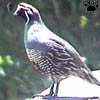
California quail
(Callipepla californica),
Headwaters Forest. |
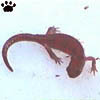 |
 |
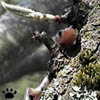 |
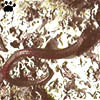 |
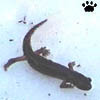 |
| Lungless salamanders
of Northern California, left to right: Ensatina eschscholtzii platensis, E.
e. oregonensis, Aneides lugubris, Batrachoseps attenuatus, Hydromantes brunus. |


Rare California tiger salamander
(Ambystoma californiense) stays
underground for most of the year, but
can be found in some vernal pools in
rainy winters. Hastings Reservation. |
Salamanders of California are particularly
interesting. There are about 30 or 40 species here (the number keeps growing,
as more research is done on their genetics), ranging in size from tiny slender
salamanders (Batrachoceps) to 7'/20 cm-long Pacific giant salamanders (Dicamptodon).
Most are found in wet coastal forests, but some inhabit desert oases or mountains
above timberline. Only a few species are common and widespread, so seeing all
of them requires a lot of time and effort. You have to look under thousands of
rocks and rotten logs. |


Pacific giant salamanders -
D. ensatus, shown here, and its
relatives - are not rare, but difficult
to find in rivers and moist forests of
the Pacific Coast. Redwood N. P. |

Black bears (Ursus americanus),
Redwood National Park. |
There are relatively few large mammals
in Northern California, but you still get to see some interesting interactions. |

Mule deer (Odocoileus hemionus) in our
parking lot, Santa Cruz Mountains. |
 |
 |
 |
 |
| Roosevelt elk (Cervus
canadensis roosevelti) chasing mule deer (don't ask me why). Prarie Creek
Redwoods State Park. |
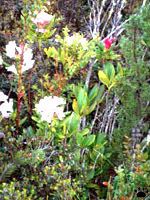
Pygmy rhododendron and manzanita,
Pygmy Forest, Van Damme Park. |
Not far from the world's largest conifers,
you can see the world's smallest ones. In Pygmy Forests of Mendosino White Plains,
there are 200-year old trees less than 1' (30 cm) tall. These natural bonsai-like
forms of lodgepole pine (Pinus contorta bolanderi) and Gowen cypress (Cypressus
goveniana pigmaea) are created by poor soil conditions. Some insects, mites
and plants, such as manzanita Arctostaphylos nummularia, do not live outside Californian
pygmy forests. |
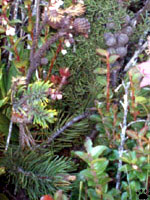
Pygmy cypress and pine,
Pygmy Forest, Salt Point. |
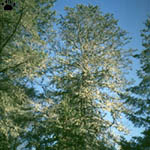 |
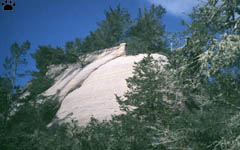 |
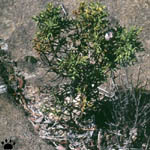 |
| Santa Cruz Cypress (Cupressus
goveniana abramsiana) grows only on sandstown outcrops in Central California,
sometimes as a bonsai (right photo). Boonie Doon. |
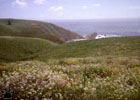
Spring, Point Reyes Peninsula |

Offshore rocks, Mendocino Coast |
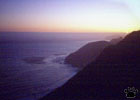
Sunset, Big Sur Coast |
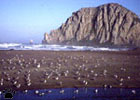
Gull flock, Morro Bay |
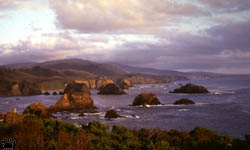
Sunset near Point Arena. |

Calif. condors
(Gymnogyps
californianus) in a giant
redwood,
Big Sur. |
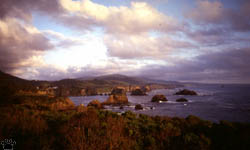
Sunset near Point Arena. |

Hot lake, Lassen Volcano. |
Summit views, Lassen Volcano.
Northeastern California is the world of volcanoes, lakes, lava plains and dry
pine forests. |
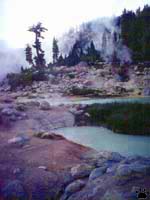
Cold lake, Lassen Volcano. |
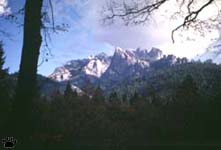
Castle Crags, nesting site of peregrine falcons (Falco
peregrinus), and a nice place for rock climbing. |
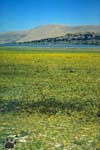
Clear Lake Reservoir,
habitat of 3 endangered fishes. |
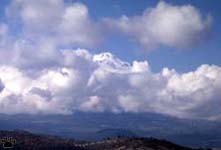
View of Mount Shasta (4317 m/14162'), the tallest of
California's three active volcanoes. |
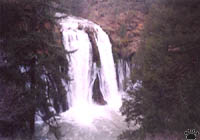
Double-layer falls on McArthur River - habitat
of black swifts (Cypseloides niger), and two
rare species of sculpins (Cottus). |
As any other part of California, it has its share
of rare flora and fauna.
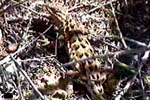
Side-blotched lizard (Uta
stansburiana), Goose Lake. |
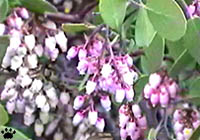
Salal (Gualtheria shallon) is one of the most
common shrubs of Northern California. It can
have white or pink flowers. Ishi Wilderness. |
 |
Views from the summit of Mount Shasta. |
 |
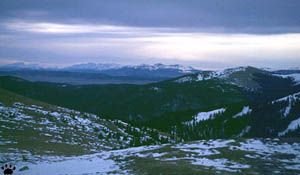
November in Warner Mountains, California. |
Part 2: Sierra Nevada
Home
|